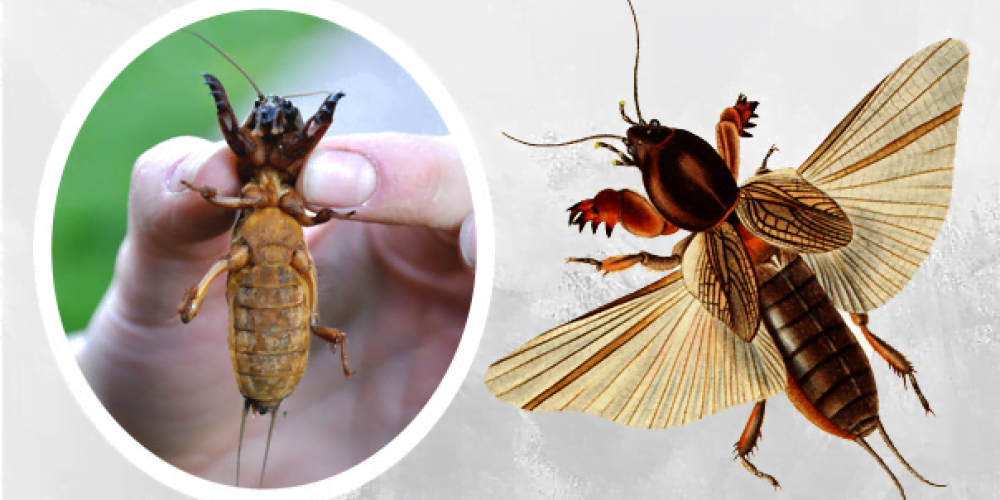Borer insect (dogfish): Mole crieket Gryllotalpa gryllotalpa
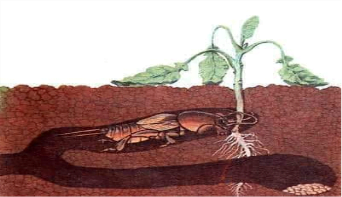
The borer (dogfish) is a harmful insect that attacks nymphs, adults, and seedlings (young plants) under the soil surface. It is most abundant in light soils, when excessive organic fertilization is done, and when planting tuber vegetables. Therefore, this insect is considered dangerous and needs prevention and treatment before plants are damaged and crops are lost. The insect spreads in hot and warm areas in the Mediterranean basin. So let's get to know the borer insect (dogfish).
Describe the shape and behavior of the borer insect
The borer insect is considered large in size, 5 cm long. It is a member of the arthropod phylum of the hexapod class. It is winged and its wings are straight-winged. The front ones are thick and short, and the back ones are long, enabling them to fly, and when at rest they slide under the front wings. The insect is bright brown above and bright yellow below, and the body is covered with short hair.
All stages of the insect are located underground in tunnels. The nymphs and adults attack the cold ones from below, leading to their death after they dry up. The front legs have modified to help them dig.
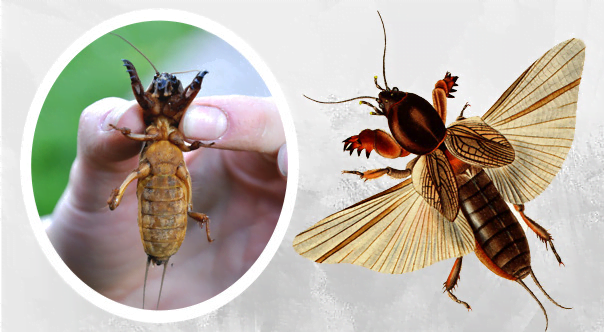
The female digs two types of tunnels, one used for feeding, which is winding and surface, and is often found in wet soil. The other type is deep and is used to store food and lay eggs. It is 15-20 cm deep, and sometimes it may reach a meter. The nymphs may spend the winter in these tunnels before emerging into the superficial layer of soil.
Reproduction in the rig (dogfish)
The male begins to dig a tunnel in the soil and makes a sound through friction with his front feet, which attracts the females. After mating, the female takes the initiative to complete the tunnel and create the egg-laying chamber. The female lays eggs from mid-April and continues to lay eggs until she lays about 500 eggs.
The eggs hatch after about 20 days, and the nymphs emerge and molt 10 times before reaching the adult insect. The adult insect emerges in the fall. Nymphs that have not yet matured may spend the winter inside the tunnels and then emerge. One generation is completed within a year. The adult insect lives about 9 months.
Rigger damage (dogfish)
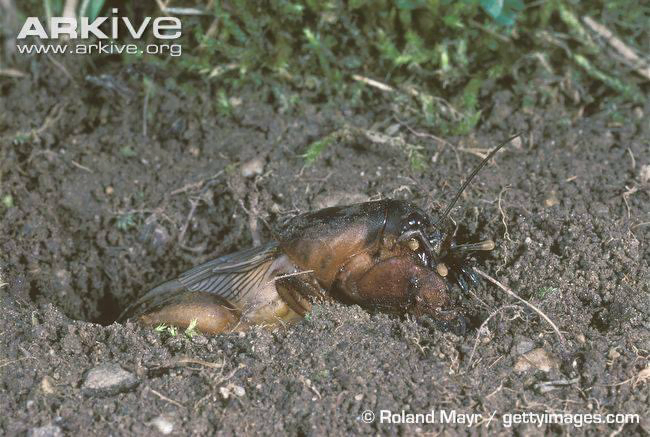
The insect's damage is that it feeds on the roots of plants, most importantly vegetables, which reduces production and leads to the loss and death of many plants. As the adults and nymphs feed on the lower part of the plants, which leads to their drying and death. The borer also attacks fruits close to the soil surface, such as squash andtomatoes And change it. Also, the insect may attack seeds when planted in the soil, which reduces the density of plants in the field, which affects production and leads to financial loss.
Symptoms that indicate the presence of a rig (dogfish)
1- The absence of some injustice in scattered spots.
2- Watching wilted and dry seedlings while standing.
3- Note the locations and paths of some tunnels, especially after irrigation.
Appearance of injury and damage:
1. A scratchy appearance on the soil surface and in water channels.
2. Nymphs and adult insects feed on plant seeds and seedling roots below the surface of the soil. The seedlings appear wilted and stand in place and are easily uprooted due to the loss of the root system.
3. Nymphs and adult insects attack tubers buried in the soil, such as potato tubers and yams, and cause the tubers to rot and spoil.
4. Nymphs and adult insects attack fruits sitting on the surface of the soil, such as tomatoes and watermelon, causing rot and spoilage of the fruits.
life cycle :
These insects live in tunnels made by the female in the soil, and they also appear on the surface of the soil, but they are attracted to light on summer nights and collide strongly with lamps. The females make two types of tunnels: The first type is slightly below the surface of the soil and is winding, with a diameter of 1:1.5 cm. It is called a living tunnel, and insects live inside it. As for the second type, it is inclined to the surface of the soil at a depth of up to 15.20 cm. This tunnel is intended for storing food (food warehouse), and in general The first type of tunnel opens with an opening to the outside. The external opening leads to a tunnel called the guard tunnel. On one side of this tunnel, the female builds one or more chambers from clay mixed with plant parts that are wider than the diameter of the tunnel (up to about 5 cm in diameter). This room is allocated for laying... Eggs and mating. The female begins laying eggs during the months of April and May, and egg laying may continue throughout the summer. The female lays about 25 eggs in each room. 28 eggs, and the female describes about 500 eggs in her life, and the eggs are rather large in size, oval in shape, and their color is light hazel. The female remains in the guard tunnel without food until the eggs hatch after about 3 weeks. The nymphs remain in the room for a few days until the wall of their body hardens. Then it emerges outside through an outlet made for it by the mother and begins its independent activity. The nymph molts 10 times, and it takes 18 months for the nymph to reach the juvenile stage. Juvenile insects emerge in October and November, and the size of the nymph is very small compared to the size of the juvenile insect when it hatches. Then it gradually grows, and it resembles its parents except that its wings are not developed, but the protrusions of these wings appear in successive molts. The juvenile insect lives for 9 months, and the females that emerge in October and November begin laying eggs in April and May, as previously mentioned, and the life cycle is repeated. Therefore, this insect has one generation every two years.
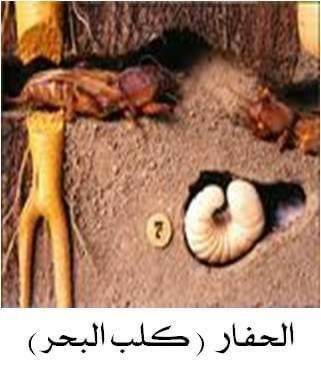
Ways to prevent borers (dogfish)
1- Deep plowing to expose the nymphs and adults to the sun and biological enemies.
2- Do not increase organic fertilization because it attracts and reproduces this insect.
3- Getting rid of weeds as they are a suitable host for the borer insect.
4- Immerse the land affected by the borer with water for two days before starting planting.
5- Use 20 liters of diesel through irrigation per acre to get rid of the borer.
6- Apply a protective bait before planting and after planting vegetable crops
Methods of treatment and control of borers (dogfish)
The borer infestation is treated by using poisonous baits. These grafts are used when the infection becomes severe. The grafts are:
Use 1 kg of semi-grinder, in addition to 1 kg of molasses, 20 kg of corn grits, and a bunch of chopped clover. Add 20 liters of water to the mixture. Here, pesticides were not used, only alum was used, and this is used in new lands. In old lands, an insecticide is added at a rate of 300 cm per acre with the previous mixture. It will be more effective and is permitted in old lands. In infested and old lands, only an insecticide is used with the previous mixture without using alum.
Then mix the grafts well and leave them to ferment, then place them in a slurry or in spots around the plants near irrigation lines and irrigation channels at sunset on the day of irrigation.



